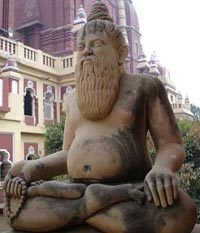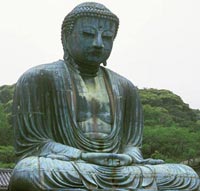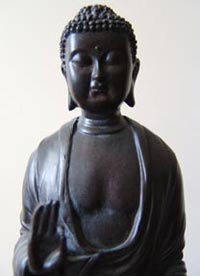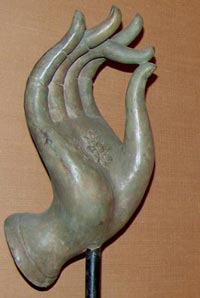Creating a Habit
 Many a time we do not get to meditate, as whenever we have the time we cannot find the will, and when we have the will, we cannot find the time. We tend to look at meditation as something we should want to do, and therefore shudder at the idea of making it a force of habit. Yet, on occasion, this reasoning, only serves as an excuse to avoid something we do really wish to do – meditate. In such instances, creating a habit is desirable.
Many a time we do not get to meditate, as whenever we have the time we cannot find the will, and when we have the will, we cannot find the time. We tend to look at meditation as something we should want to do, and therefore shudder at the idea of making it a force of habit. Yet, on occasion, this reasoning, only serves as an excuse to avoid something we do really wish to do – meditate. In such instances, creating a habit is desirable.
If you look to jump-start your meditation practice, set an obtainable goal. Begin with as little as 10 minutes a day, knowing you may not get deep into a meditative state but that you are creating a habit which will pay off long-term, and maybe even sooner than you’d expect. Find a place at your house which makes you feel relaxed, and pick a time that is already part of your routine; for example, deciding you are going to meditate after brushing teeth in the morning or evening. Lower your expectations. All you are doing is forming a habit. Allow two to four weeks for nothing to really happen - just sit daily for a few minutes and observe thoughts rushing though a possibly restless mind. As the time you dedicate to the practice becomes part of your routine, you may be tempted to sit longer.
If you are familiar with meditation techniques, you can then start to apply them. If not, please join us for one of our up and coming meditation sessions or look for an up and coming meditation gathering in your area. Try different places and different techniques. Experiment. Listen to no one who tells you there is only one way to meditate, one path. You will find your own unique path. And most importantly – don’t wait to start tomorrow as tomorrow will soon be next week, next month, next year.
Environment
Most people find it easier to have a special environment for meditating, at least when they begin. A designated location is a good idea so long as you don’t “get married” to that specific space; i.e. start to believe you cannot meditate under any other conditions.  Choose a favorite area – a special corner, room, etc. Pick space that feels “right” and is accessible year-round. Some like to have a special pillow or chair (for sitting meditation,) which again, is nice so long as you don’t make it the central piece of your practice. Ultimately you want to be able to meditate anywhere and anytime – making your life one long open-eyed meditation session.
Choose a favorite area – a special corner, room, etc. Pick space that feels “right” and is accessible year-round. Some like to have a special pillow or chair (for sitting meditation,) which again, is nice so long as you don’t make it the central piece of your practice. Ultimately you want to be able to meditate anywhere and anytime – making your life one long open-eyed meditation session.
Some find that activating the sense of smell is helpful in further creating the right environment. You can try different types of incenses or aromatherapy oils, noting which creates a supportive mood. Music is another tool some practitioners find helpful. Pick the sort of music that helps anchor you in the now without making you too jumpy or sleepy. Instrumental music is preferable, as lyrics can impede your focus.
Sitting
 There is no one right position for sitting. There are only guidelines to keep in mind. The main point is that your sitting position is intended to keep your spine straight and elongated. Maintain elongation through breathing, not through muscle tightening. The traditional yogic way of sitting is with legs positioned in one of several ways – just crossed (easy-pose,) one leg in front of the other, semi-lotus, or full lotus. In essence you are keeping your lowest chakra (energetic center, the muladhara chakra) as close as possible to the ground, and the back erect. Shoulders should be relaxed and chest area open, nape aligned with the spine, and head stretched but not strained.
There is no one right position for sitting. There are only guidelines to keep in mind. The main point is that your sitting position is intended to keep your spine straight and elongated. Maintain elongation through breathing, not through muscle tightening. The traditional yogic way of sitting is with legs positioned in one of several ways – just crossed (easy-pose,) one leg in front of the other, semi-lotus, or full lotus. In essence you are keeping your lowest chakra (energetic center, the muladhara chakra) as close as possible to the ground, and the back erect. Shoulders should be relaxed and chest area open, nape aligned with the spine, and head stretched but not strained.
If you prefer chair meditation, sit on the edge of the chair. This position will help support correct back posture. Keep the legs body-width apart, knees bent ninety degrees and the sole of the feet flat against the ground. Place your hands on the thighs close to the knees so the arms are relaxed and the palms facing are up (or down.) Maintain a tiny, almost invisible smile, to assist with keeping the face muscles relaxed. Close your eyes and focus internally on the “third eye” (center of the forehead.) And again, experiment...
 Movement and Adjustments
Movement and Adjustments
Though sitting straight, do not sit rigid. If slight movement comes to your body, neck or head, allow it, but avoid making it a focal point and thus a distraction.
Sit still but if you need to move - adjust a sitting position or scratching, do it mindfully with awareness. The following story comes to mind: Gautama Buddha was having lunch with Ananda, his disciple, when a fly situated itself on Buddha’s forehead. Buddha waved his hand and the fly took off. Ananda thought nothing of it until, a moment later, he noticed his Master waves his hand again, this time without any fly around. “Master,” wondered Ananda, “I understand the first time, waving the hand to get the fly off, but why the second time?” “The second time, my dear Ananda,” replied the Buddha, “was because I was not mindful waving the fly off the first time.”
Thoughts
 There is a common conception that once you start to meditate, your mind will immediately become empty of thought. It is a misconception for beginners and one that may have caused the most damage in terms of deterring people from continuing with the practice long-term. Even experienced meditators rarely vacant their minds for an extended amount of time. So let’s get this straight right from the start: thoughts will come to your mind. Don’t fight it. Just observe and let them go. New ones will come to replace those gone – remain watchful and let go. Your practice initially should be focused on not clinging the mind’s whims, nor on emptying your mind. Over time you will start to discover small spaces between the rise of thoughts, spaces which will start to grow. But it takes time, or, as the song goes, you can’t hurry love.
There is a common conception that once you start to meditate, your mind will immediately become empty of thought. It is a misconception for beginners and one that may have caused the most damage in terms of deterring people from continuing with the practice long-term. Even experienced meditators rarely vacant their minds for an extended amount of time. So let’s get this straight right from the start: thoughts will come to your mind. Don’t fight it. Just observe and let them go. New ones will come to replace those gone – remain watchful and let go. Your practice initially should be focused on not clinging the mind’s whims, nor on emptying your mind. Over time you will start to discover small spaces between the rise of thoughts, spaces which will start to grow. But it takes time, or, as the song goes, you can’t hurry love.
Tactics
When you find yourself distracted, when your mind goes into overload again and you float away mindlessly, noticing it only minutes later, don’t panic.  Everyone experience this. Don’t use it as an excuse to give up. Just resume your meditation without being critical. A good way to address clinging thoughts is to use one of the two following replies: 1. “I don’t know” 2. “I don’t care”. Try it – it works like magic...
Everyone experience this. Don’t use it as an excuse to give up. Just resume your meditation without being critical. A good way to address clinging thoughts is to use one of the two following replies: 1. “I don’t know” 2. “I don’t care”. Try it – it works like magic...
Another nice technique is to observe your breathing. Since breathing can only happen in the now, it is a good anchor for the present. Become aware of everything about your breath: is it abdominal or in your chest? Fast or slow? Deep or shallow? Harsh or soft? Don’t be judgmental – there is no right or wrong. There is only what happens now. Take note also of the path of your breath – feel it tickling from the external part of the tip of your nose, through the nostrils, throat, chest, abdominal area, the expansion of the body to the sides and back, etc. You can also count the breaths – count ten and repeat. Yet remember, this is not a “goal,” it is just a technique to help you focus on the now.
Hand Position
 Much has been said and written about hand positions, or mudras. Though various positions have different meanings and create various moods and energetic flows, they are not to be a focal point for a beginner. Keep your hands on your knees (if in sitting meditation) in a way that is comfortable. Palms generally face up but if you prefer it facing down, try it that way as well. Keep the hands open but not forced open. A common yogic hand position is called Chin Mudra: thumb and index finger join as a circle, lightly touching. The rest of the fingers are extended out, with the middle finger touching the non-folded part of the index finger.
Much has been said and written about hand positions, or mudras. Though various positions have different meanings and create various moods and energetic flows, they are not to be a focal point for a beginner. Keep your hands on your knees (if in sitting meditation) in a way that is comfortable. Palms generally face up but if you prefer it facing down, try it that way as well. Keep the hands open but not forced open. A common yogic hand position is called Chin Mudra: thumb and index finger join as a circle, lightly touching. The rest of the fingers are extended out, with the middle finger touching the non-folded part of the index finger.
 Another common hand position is taken from Zazen, a particular kind of meditation, unique to Zen. The hands are folded in the cosmic mudra. The dominant hand is held palm up holding the other hand, also palm up, so that the knuckles of both hands overlap. If you're right-handed, your right hand is holding the left hand; if you're left-handed, your left hand is holding the right hand. The thumbs are lightly touching, thus the hands form an oval, which can rest above or on top of your feet (depending which sort of seating you use).
Another common hand position is taken from Zazen, a particular kind of meditation, unique to Zen. The hands are folded in the cosmic mudra. The dominant hand is held palm up holding the other hand, also palm up, so that the knuckles of both hands overlap. If you're right-handed, your right hand is holding the left hand; if you're left-handed, your left hand is holding the right hand. The thumbs are lightly touching, thus the hands form an oval, which can rest above or on top of your feet (depending which sort of seating you use).
Don’t get married to the idea of what hand positions do. Experiment. Observe how different hand position affect your mental, emotional and energetic state of being, and therefore the quality of your meditation. If you watch pictures and sculptures of the Buddha meditating, you will see many different mudras. Buddha was not shy about experimenting, nor should you be.
The Three Yogis
The story goes about a young spiritual aspirant who was traveling on his way to visit a remote temple. As his first day of the journey was coming to an end, he noticed a man sitting on the side of the road in a meditative pose, constantly moving and muttering. The young traveler wished to meditate as well, and, seeking company after spending a long day alone on the road, approached the man and asked if he can join him. “You don’t want to join me,” muttered the man. “I am such a failure.” “Why are you saying this?” wondered the yogi aspirant aloud. “Well, I sit down to meditate and immediately my body starts to ache, my mind races in one thousand directions. I cannot wait for this to be over, I don’t understand why I am even trying – I am just not good at this. Why bother? There is no hope for me.”
 The following evening, after another long day on the road, our young aspirant finds rest at a small roadside motel. After a short nap he goes out and notices the motel manager, a man in a shabby suit, sitting in a meditative pose. As the manager was just situating himself in a sitting position, our young aspirant approaches him and asks permission to join him. “Are you sure you really want to do this?” asks the manager. “What do you mean?” asks the aspirant. “Well, what are you getting from this sitting? Does it really liberate your mind? Say, if you spend ten minutes meditating, how long will the liberation last? Five minutes? Is the tradeoff of your time worth it? Is it a good deal? And what if you spend thirty minutes meditating and nothing really happens? Is it worth it still?”
The following evening, after another long day on the road, our young aspirant finds rest at a small roadside motel. After a short nap he goes out and notices the motel manager, a man in a shabby suit, sitting in a meditative pose. As the manager was just situating himself in a sitting position, our young aspirant approaches him and asks permission to join him. “Are you sure you really want to do this?” asks the manager. “What do you mean?” asks the aspirant. “Well, what are you getting from this sitting? Does it really liberate your mind? Say, if you spend ten minutes meditating, how long will the liberation last? Five minutes? Is the tradeoff of your time worth it? Is it a good deal? And what if you spend thirty minutes meditating and nothing really happens? Is it worth it still?”
On the third and last day of his journey the aspirant finally reaches the temple. At the outskirts of the temple, with a marvelous sunset at the backdrop, he sees what can only be described as the perfect yogi: a man whose olive skin is shiny, his face second only to Buddha’s, sitting in a perfect full lotus pose, his eyes closed, his breaths deep and slow. Our aspirant tiptoes close by and sits himself close to what must be nothing less than God’s incarnation upon earth. As he folds his legs and places his hands on his knees, he realizes the perfect yogi is watching him. “Excuse me noble Sir, I really didn’t want to disturb you,” mumbles the aspirant, his lowered to the ground. “Ha,” laughs the yogi, “that’s okay. Just watch my perfect pose. You can learn a lot from watching and admiring my perfection. I know how to sit and meditate. There is nothing anyone can teach me about this that I don’t already know. I am so good at it that it is almost frustrating.”
 The next morning our aspirant enters the temple where he meets the local priest. “Welcome young traveler!” exclaims the priest with a warm smile. “Come, sit here and tell me a little about your journey and whom you met along the way. The young aspirant sits down and tells the priest about his encounters. “Oh,” laughs the priest, “so you met the three yogis!” “The three yogis?” asked the aspirant surprised. “Yes, you met the Complete Failure yogi first; the one who told himself right from the start he will never be able to meditate, and, sure enough, he is so busy fulfilling his own prophecy that he sees nothing but his imperfections. Then you met the businessman. This yogi is very calculative and meditating is for him similar to conducting business. It is all measured and assessed. His meditation is thus limited to that capacity. And finally, just outside this temple, you met the worst of them all – the proud yogi” “Worst?” wonders the aspirant aloud, “he seemed to me to be a perfect yogi.” “Hehehe” the priest burst out laughing. “Perfect – sure: wrapped in pride he sees nothing but the shiny gate, never wondering what he may find if he stops only for a moment admiring the façade and look inside. When a practitioner reaches this state of mind it is very difficult to make him see the false pedestal on which he positioned his own image. He is too far, remote and full of himself. I actually like having him sitting outside this temple – he is a good reminder to me and others of a path we want to steer clear.” “If so, dear priest, what path should I take? Now that you have illustrated these three yogis to me I realize I have experienced these states of mind in myself at different points of my practice.” “Indeed,” answers the priest, “we all, on occasion, have been a complete failure, a businessman and even a proud yogi. But if one can recognize these states of mind, one does not fall into these traps but continue on the path of discovering what meditation means to you. And only you can make that discovery – never let another tell you what your meditation should be like.”
The next morning our aspirant enters the temple where he meets the local priest. “Welcome young traveler!” exclaims the priest with a warm smile. “Come, sit here and tell me a little about your journey and whom you met along the way. The young aspirant sits down and tells the priest about his encounters. “Oh,” laughs the priest, “so you met the three yogis!” “The three yogis?” asked the aspirant surprised. “Yes, you met the Complete Failure yogi first; the one who told himself right from the start he will never be able to meditate, and, sure enough, he is so busy fulfilling his own prophecy that he sees nothing but his imperfections. Then you met the businessman. This yogi is very calculative and meditating is for him similar to conducting business. It is all measured and assessed. His meditation is thus limited to that capacity. And finally, just outside this temple, you met the worst of them all – the proud yogi” “Worst?” wonders the aspirant aloud, “he seemed to me to be a perfect yogi.” “Hehehe” the priest burst out laughing. “Perfect – sure: wrapped in pride he sees nothing but the shiny gate, never wondering what he may find if he stops only for a moment admiring the façade and look inside. When a practitioner reaches this state of mind it is very difficult to make him see the false pedestal on which he positioned his own image. He is too far, remote and full of himself. I actually like having him sitting outside this temple – he is a good reminder to me and others of a path we want to steer clear.” “If so, dear priest, what path should I take? Now that you have illustrated these three yogis to me I realize I have experienced these states of mind in myself at different points of my practice.” “Indeed,” answers the priest, “we all, on occasion, have been a complete failure, a businessman and even a proud yogi. But if one can recognize these states of mind, one does not fall into these traps but continue on the path of discovering what meditation means to you. And only you can make that discovery – never let another tell you what your meditation should be like.”
Results
Why are you meditating? What are you hoping to achieve?
 These may sound like questions the businessman yogi will ask but nevertheless, questions you are probably asking, admittedly or not.
These may sound like questions the businessman yogi will ask but nevertheless, questions you are probably asking, admittedly or not.
You are not alone. Most, if not all meditators meditate for a reason: to relax and de-stress, to advance spiritually and, who knows, maybe even to achieve enlightenment.
It’s okay to have motivation to meditate or else our calculative mind will not allow us to find time for it. Come up with whatever reason you want, but, when you begin your practice, refocus. If you do this for a reason, you are meditating for something that will happen in the future and thus you are not in the present. And meditation can only happen in the now. You cannot practice mindfulness in the future nor in the past.
If you are still bothered that you have goals when practicing meditation, or if you live in denial about having goals, here is something you can do: ask yourself why do I breathe, or better still, why do I live?
If you have a reason for living that is in the future, what will happen when, God forbid, you fulfill that goal? Will you instantly perish?
You live because... you live. You breathe because... you breathe, you meditate because... you meditate – because ultimately you may come to see that life, breathing and meditation are all one and the same.

About the author: Ronen Divon has been a spiritual seeker of many years. He teaches Hatha Yoga, Tai Chi and Qigong, as well as an author of stories for children and adults.
Special Thanks to Star Galler for her comments and contributions to this article. Star is a Yoga instructor and an exceptional classic realist artist. Her phenomenal work speaks for itself. Click here to visit her site. Star is available for commissioned work.
Interested in posting any of these articles on your web site? Please click here to obtain permission. We will typically allow publishing, free of charge, on other sites that we deem appropriate, so long as the articles are not edited, and authorship credits as well as a link back to this site are posted together with the article.
© 2010 Ronen Divon. All Rights Reserved.